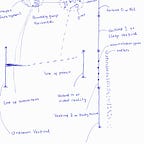DSM-5-TR | LLMs | Anosognosia: Signals Psychopathology for Mental Illness, Drug Addiction
There is a recent exploration in Scientific American, Why Do So Many Mental Illnesses Overlap? stating that, “scientists say there exists a propensity to develop any of a range of psychiatric problems. They call this predisposition the general psychopathology factor, or p factor. This shared tendency is not a minor contributor to the extent to which someone develops symptoms of mental illness. In fact, it explains about 40 percent of the risk. More evidence that the DSM’s boundaries are soft, if not fictitious, has to do with the observation that many, if not most, people with a mental illness — as many as 82 percent of those with schizophrenia, recent data suggest — exhibit symptoms that cross those boundaries, sometimes leading to multiple diagnoses. For instance, individuals with depression often have anxiety, and those with post-traumatic stress disorder (PTSD) are likely to have a substance use disorder.”
Conceptually, all psychiatric disorders are problems of the human mind, exceeding another label, p, or condition segmentations in the DSM-V text revision. Though there are genetic and environmental correlations to disorders, anything has to affect the elements of the mind to become a problem [for social or occupational functioning]. People living with mental illnesses are still missing how the human mind works, at least conceptually, for what is mechanized — before, during and after episodes. The same applies to those living with substance use disorder.
Medical science has easier descriptions of what happens when someone takes too much sugar, salt, listens to too loud sound, get exposed to too much cold and so forth, with explanations that ensure that consequences are helpful as deterrents.
Neuroscience has explanations of how drugs affect the brain, but it is often center-based, like the changes in the reward center, or molecule-based, specifying dopamine, instead of a general drug use-to-mind-to-affect universality. Psychiatry has assessments to diagnose conditions. A way to make progress against disorders is to map the mind and factor the variations that correlate with disorders.
Conceptually, the human mind has two components, electrical and chemical signals of neurons, with their features and interactions, in sets. It is these signals that carry out all functions of mind, with qualifiers that modify those functions. These qualifiers group as consciousness, the super qualifier.
Functions include major divisions like memory, emotions and feelings, with several subdivisions like pain, hurt, love, craving, delight, fear, intelligence, thoughts and so forth. All these functions are not often happening at the same time, because they are graded by qualifiers.
Several [illegal] drugs are not the only things that do what they are capable of, to the human mind. So, how does the mind work that allows for used substances to take over into disorder? How do the functions [and their qualifiers] of mind vary in a psychiatric disorder, for a parallel of what might be ongoing within?
This could become a display to be aware of states of mind [or signals psychopathology], as the proximal pathway of the mind, for the affected and loved ones, to know how to seek alternatives or approach therapy, leaping the Hierarchical Taxonomy of Psychopathology (HiTop).
Generative AI is already useful in cognitive behavioral therapy [CBT]. The difference here will be to describe disorders by the functions of mind and how they are qualified, extended by a large language model, a VR headset or other platforms. This would be helpful to point, almost directly to experiences for the way they simmer on the mind, with alertness for how to react. It will also be useful to explain the difference between order and disorder against anosognosia.
For example, with craving [in attention], where if not satisfied by something else, it may seek reward only with drugs. Or, that if anxiety might be likely, then to prepare memory counters, when in the situation, rather than to abuse drugs — whose consequence, per use and cumulatively, can be displayed.
Functions of mind are the interactions of the electrical and chemical signals. Features are qualifiers like splits, prioritization, pre-prioritization, intent or free will, subjectivity, distribution, sequences, arrays and principal spot.
Principal spot is common in addictions depression, compulsion, and so forth, where a set of signals, move to a spot, and then dominate, drawing the qualifiers of functions, to give whatever function, precedence. Showing the mind could become a form of harm reduction in mental and substance use disorders.
Knowing how the mind works, conceptually, may not cure addictions or mental illnesses, but could empower the mind, for a state of awareness, against a complete grip.
